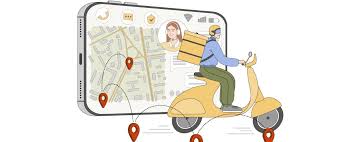The delivery economy is growing rapidly in 2025. There has never been a greater need for on-demand delivery, whether it be for groceries, food, pharmaceuticals, or logistics services. By developing their delivery apps, companies of all sizes hope to seize this chance to improve, brand, and scale their delivery experiences in addition to meeting customer expectations.
If you’re planning to turn your delivery app idea into a reality, you’re in the right place. This step-by-step guide will walk you through the entire journey—from initial concept to final launch—so you can build a custom delivery app that fits your business goals in 2025.
Step 1: Define Your App’s Purpose and Niche
Before jumping into development, you need clarity on:
- What will your app deliver? (Food, groceries, medicines, parcels, etc.)
- Who is your target audience? (Consumers, vendors, delivery agents, or businesses?)
- What pain points are you solving? (Slow deliveries, lack of tracking, limited options?)
- Who are your competitors? (Swiggy, DoorDash, Instacart, Dunzo, etc.)
A clear niche helps shape your features, business model, and tech decisions from day one.
Step 2: Choose a Business Model
Depending on your goals, you can choose among various delivery app models:
- Single-store model – For a specific business offering direct delivery (e.g., a restaurant or flower shop).
- Multi-store marketplace – A platform connecting multiple vendors with users and delivery agents.
- Logistics/fleet-based model – For courier or delivery fleet management.
- Subscription model – For routine deliveries (e.g., milk, meal kits, medicine refills).
Your business model will influence how your app handles orders, users, commissions, and logistics.
Step 3: Finalize Core Features
A delivery app typically includes three main interfaces:
- Customer App
- Delivery Agent App
- Admin Dashboard
Key features for your delivery app may include:
Customer App:
- User registration & login
- Browsing/search functionality
- Real-time tracking
- Multiple payment options
- Order history & reordering
- Reviews and ratings
- Notifications
Delivery Agent App:
- Order assignment & updates
- Route navigation
- Status updates (picked, on the way, delivered)
- Earning summary
- In-app chat with support
Admin Dashboard:
- Order management
- User management
- Delivery tracking
- Payment analytics
- Promotions & offers
- Fleet or partner coordination
Depending on your use case, you can integrate AI, geofencing, loyalty rewards, or AR-based features.
Step 4: Select the Right Tech Stack
Choosing the right technologies is crucial to ensure speed, scalability, and performance. In 2025, most delivery apps will be built using:
- Frontend: React Native / Flutter for cross-platform mobile development
- Backend: Node.js, Python (Django/Flask), or Ruby on Rails
- Database: PostgreSQL, MongoDB, or Firebase
- Maps & Location: Google Maps, Mapbox, OpenStreetMap APIs
- Push Notifications: Firebase Cloud Messaging, OneSignal
- Payment Gateways: Stripe, Razorpay, PayPal, Apple Pay
- Cloud Hosting: AWS, Google Cloud, Microsoft Azure
Looking to integrate AI? Consider tools like OpenAI, Dialogflow, or custom machine learning models for chatbots and delivery optimization.
Step 5: Design a User-Friendly UI/UX
Your app’s design will influence:
- How quickly users place orders
- How easily drivers navigate and update deliveries
- How frequently do customers return
Prioritize simplicity, speed, and usability. Use a clean layout, intuitive navigation, and fast-loading pages. Always design mobile-first, with responsiveness and accessibility in mind.
Step 6: Develop, Test, and Iterate
You can either:
- Build in-house with your team
- Hire a professional development company specializing in delivering apps
- Use no-code/low-code platforms for a quicker MVP (minimum viable product)
Regardless of the route, always:
- Break the development into sprints
- Test each module (functionality, security, performance)
- Gather feedback from beta users
- Refine before launching at scale
In 2025, agile and DevOps practices are key to faster releases and updates.
Step 7: Integrate Logistics & Partner Support
If you’re not running your fleet, you’ll need:
- Logistics partners for delivery (local couriers or fleets)
- Vendor support for multi-store platforms
- Third-party integrations for inventory, POS, and CRM systems
APIs and automation can help streamline these connections.
Step 8: Launch and Market Your App
Before launching:
- Do a soft launch or beta release in a smaller area
- Fix bugs and gather early feedback
- Prepare backend infrastructure to scale
Marketing channels that work well in 2025 include:
- Hyperlocal ads (Google, Meta, TikTok)
- Influencer marketing in your target niche
- Loyalty rewards for referrals and reviews
- SEO-optimized app landing page
- App Store Optimization (ASO)
Step 9: Monitor, Optimize, and Scale
Post-launch, success depends on continuous improvements. Track metrics like:
- Order volume
- Delivery time
- Customer retention
- App crashes and downtime
- Agent satisfaction
Use AI-powered analytics tools for forecasting, automation, and user behavior analysis to make your app smarter with every update.
Conclusion: The Time to Build Is Now
Developing your delivery app in 2025 is a smart decision for long-term success, since delivery services are becoming a necessary component of everyday life. Offering personalized experiences, controlling your data, streamlining processes, and lowering dependency on outside platforms are all made possible by it.
